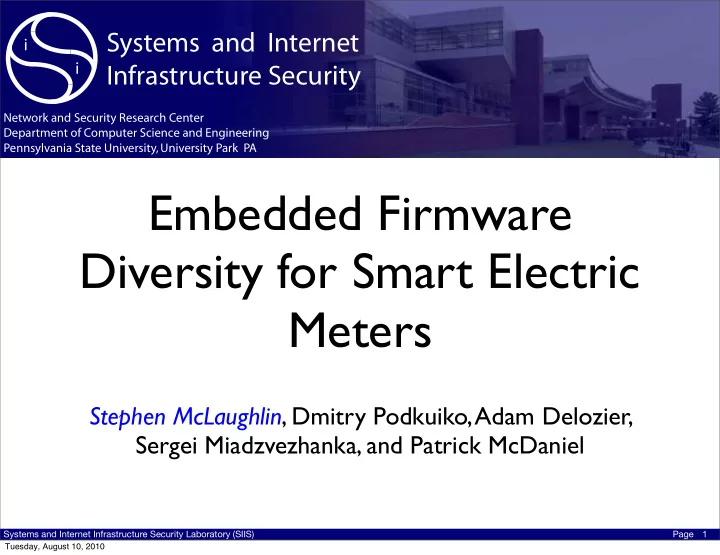

������� ��� �������� �������������� �������� � � ������� ��� �������� �������� ������ ���������� �� �������� ������� ��� ����������� ������������ ����� ��������������������� ���� �� Embedded Firmware Diversity for Smart Electric Meters Stephen McLaughlin , Dmitry Podkuiko, Adam Delozier, Sergei Miadzvezhanka, and Patrick McDaniel Systems and Internet Infrastructure Security Laboratory (SIIS) Page 1 Tuesday, August 10, 2010
Smart Meters Electromechanical Smart Meter Systems and Internet Infrastructure Security Laboratory (SIIS) Page 2 Tuesday, August 10, 2010
3 Concerns Fraud - Hacking meters to reduce energy bill Privacy - Using detailed load profiles to determine behavior Blackout - Exploiting large numbers of meters and cutting power Systems and Internet Infrastructure Security Laboratory (SIIS) Page 3 Tuesday, August 10, 2010
The Problem of Meter Monocultures . . . . Systems and Internet Infrastructure Security Laboratory (SIIS) Page 4 Tuesday, August 10, 2010
The Problem of Meter Monocultures Systems and Internet Infrastructure Security Laboratory (SIIS) Page 5 Tuesday, August 10, 2010
The Problem of Meter Monocultures ☠ Systems and Internet Infrastructure Security Laboratory (SIIS) Page 6 Tuesday, August 10, 2010
The Problem of Meter Monocultures ☠☠ ☠ ☠ ☠ ☠ ☠ ☠ Systems and Internet Infrastructure Security Laboratory (SIIS) Page 7 Tuesday, August 10, 2010
A Known Mitigation: Diversity Software Diversity: Uniqueness added to the implementation, but not interfaces of a program . Caveat: Uniqueness must depend on good randomness Systems and Internet Infrastructure Security Laboratory (SIIS) Page 8 Tuesday, August 10, 2010
Limitations of Embedded Systems DiversityTechnique Limitation Address Space Layout Randomization No MMU Software Fault Isolation No protected supervisor mode Non-Executable Stacks No NX bit Stack Cookies Check code not segmented Works, but failed exploits can cause Address Encryption random errors Firmware Type Processor Type MMU Privileged Mode NX Bit RAM Repeater Controller Renesas M16C No No No 20KB Wireless Mesh Renesas H8S No No No N/A Embedded TCP/IP Lantronix DSTni-EX 186 No No No 256KB Gateway Controller Intel i386EX Yes Yes No 8MB Systems and Internet Infrastructure Security Laboratory (SIIS) Page 9 Tuesday, August 10, 2010
More Embedded Challenges • Diversity scheme hardness depends on secret size, which is related to machine word size. • Smart meter components range from 32- down to 8-bit MCUs. • This will affect the layout of some data structures in 8- and 16-bit systems, where multiple machine words will be needed to store the diversified value. Systems and Internet Infrastructure Security Laboratory (SIIS) Page 10 Tuesday, August 10, 2010
Address Encryption Normal Dereference Exploit Dereference Stack Registers Stack Registers EXPLOIT Local Local Variables Variables ⊕ ⊕ R' R' R K R K ⊕ ⊕ K Previous K Previous Frame Frame ⊕ R R' K ret , jmp , etc. ret , jmp , etc. What is normally a fault will cause FAULT unpredictable errors in embedded architectures with single, real-mode address spaces. Systems and Internet Infrastructure Security Laboratory (SIIS) Page 11 Tuesday, August 10, 2010
Redundant Address Encryption Stack Registers For three keys on Local a 16 bit MCU: Variables • 2 48 probes to compromise ⊕ ⊕ R K1 R K1 • 2 32 probes to random error ⊕ ⊕ R K2 R K2 ⊕ ⊕ R K3 R K3 A 15,000 node deployment ⊕ ⊕ ⊕ K1 K2 K3 Previous that is rate limited to 3 Frame request/second for each meter R R R requires approx. 10 years to fully compromise when using Fail Stop Compare != three keys. == ret , jmp , etc. Systems and Internet Infrastructure Security Laboratory (SIIS) Page 12 Tuesday, August 10, 2010
Binary Instrumentation • Feasible for embedded Original function call: smart meters: push A ; Save address jmp B ; Perform branch ‣ Statically linked code Instrumented function call: ‣ Explicit call and return mov D [key1_addr] ; D = K_1 instructions mov C A ; C = A xor C D ; C = C XOR D push C ; Save encrypted address ‣ Loose performance mov D [key2_addr] ; D = K_2 mov C A ; constraints xor C D ; Second redundant encryption push C ; mov D [key3_addr] ; D = K_3 • Code size must be mov C A ; xor C D ; Third redundant encryption minimized! push C ; jmp B ; Perform branch Systems and Internet Infrastructure Security Laboratory (SIIS) Page 13 Tuesday, August 10, 2010
Meter Configuration The project has been using interfaces which have not completed testing (60, 50, 104, 66, 67) to enable AMS Ops to discover and initialize installed meters. The conversion approach for the MDMS needs to be revisited to determine if the right approach is to “initialize” the MEM go live weekend, or use ORT to enable “cut-over”. Systems and Internet Infrastructure Security Laboratory (SIIS) Page 14 Tuesday, August 10, 2010
Summary • Meter monocultures ‣ Highly exposed nodes ‣ Hard to configure ‣ Same pandemic problem as other monocultures • Diversity ‣ Well understood exploit mitigation ‣ Significantly slows large scale exploit attempts ‣ Embedded diversity schemes will present their own challenges while facing less stringent performance requirements than traditional diversity techniques Systems and Internet Infrastructure Security Laboratory (SIIS) Page 15 Tuesday, August 10, 2010
Thank You Seed Questions • Are there suggestions for approaches besides diversity for mitigating large-scale meter exploitation? • How could we reduce meter TCB, thus reducing the amount of code that needs to be diversified? • Should we build redundant address encryption or explore additional diversity techniques? http://www.cse.psu.edu/~smclaugh http://siis.cse.psu.edu Systems and Internet Infrastructure Security Laboratory (SIIS) Page 16 Tuesday, August 10, 2010
Systems and Internet Infrastructure Security Laboratory (SIIS) Page 17 Tuesday, August 10, 2010
Performance Considerations Meter 1 / h MCU Gateway 1 / s Sensors Storage Device Networking 1 / d (per meter) 1 / decade 1 / decade Utility Server Utility Technician Systems and Internet Infrastructure Security Laboratory (SIIS) Page 18 Tuesday, August 10, 2010
Recommend
More recommend